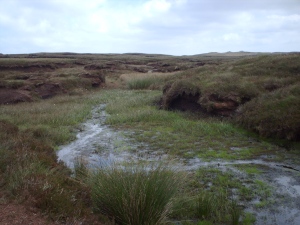 ~~~~~~~~~~~~~~~~~~~~~~~~~~~~~~~~
~~~~~~~~~~~~~~~~~~~~~~~~~~~~~~~~

The Source Spring and the first stream away from the source waters of the River Severn
The river runs from a spring beneath a peaty pool on a wild mountain also gathering waters draining through the peat from a small lake on the hill above. In a few miles it cascades over the rocks of a waterfall known as Blaenhafren. From here the stream becomes a river flowing down the forested slopes through small towns and then larger towns in Mid Wales and on into England where it turns southwards to run more or less in parallel with the border through larger towns and cities of Shrewsbury, Worcester, Gloucester, and then to the sea.The Romans called this river - and the goddess of the river - Sabrina . It was a name they took from the Brythonic, though in the earlier Welsh texts it was already in transition to its later form ‘Habren’. The Saxons called it Sæfern. So the modern name of the river in Welsh is ‘Hafren’ and in English ‘Severn’. How did this come about? There is an established pattern of sound change in early Welsh where the initial ’S’ becomes ‘H’ (perhaps via an intermediate ‘Sh’) which explains how Sabrēna becomes Habrēna. Another is that the ‘b’ in the middle of the word softens to a ‘v’ sound (represented by ‘f’ in modern Welsh). Losing the ‘a’ ending indicates a loss of the feminine deity name to that of a simple river name. So it is easy to see how the Roman Sabrina became the Welsh Hafren. But what about Severn? Clearly the saxons borrowed the name before the initial ’S’ shifted to ‘H’, but after the ‘b’ shifted to ‘f’ or ‘v’, which allows the adaptation to be dated to the end of the 6th century. Names here reflect historical as well as linguistic change.
So it is with the river itself, beginning in the Welsh heartland of Elenydd, running off the mountain of Pumlummon which Alwyn and Brinley Rees, in their book Celtic Heritage identified as the centre, comparable to Uisnech in Ireland, and where both the Severn and the River Wye have their source. The land between these two rivers, which run in different directions off the mountain before meeting again in their common estuary, stretches east across the Cambrian Mountains towards the borderlands. Between Severn and Wye is often an ambiguous terrain, where the lost sagas about the destruction of Pengwern are remembered only in fragments of verse, here from the Canu Heledd,
The Hall of Cynddylan is dark tonight
With no fire, no bed.
I weep a while, then I am silent.
It is the land where subsequently Offa’s Dyke marked the demarcation between Welsh and Mercians and later the territories of Norman ‘Marcher Lords’ pushed the border further west as they carved out their own domains between England and Wales; or the Forest of Dean, an enclave bounded by the two rivers on the western side of which the Temple of Nodens looks down over the tidal Severn from the lands of Teÿrnon Twrf Liant.
Geoffrey of Monmouth’s story about the displaced princess Habren being drowned in the river is clearly a rationalisation of the River Goddess. But his statement that “right down to our own times this river is called Habren in the British language, although by a corruption of speech is called Sabrina in the other tongue” does record confusion about the change. It also reflects shifting dynastic changes and ‘corruption’ in the line of inheritance that were still being played out in Geoffrey’s time. His King Arthur was a warrior in that conflict, while the earlier Welsh tales told of him wrestling with the great boar Twrch Trwyth as he escaped into the Severn Sea.
Much later John Milton invoked her as "Sabrina Fair" and envisaged her as "sitting, under the cool translucent wave". Here she is the tutelar goddess of the Severn Valley in a masque performed at Ludlow Castle, an aery spirit who sets "... printless feet/ O'er the cowslip's velvet head/That bends not as I tread".
This is a long way - both in miles and in sentiment - from where the waters trickle from the peat of the mountains. The way to the source of the Severn is well-marked, unlike that of the Wye which is hard to locate precisely. But these are lonely places where it can often be difficult to say which is the main stream and which are the tributary streams. The goddess, though, is featured on the waymarkers of the Sarn Sabrina, a footpath following the river along the upper reaches to the source. This has more recently been incorporated into a longer path called the Severn Way with a waymarker displaying the symbol of a sailing boat instead.

